1 - 14 of 14 records
JM-178: Pan-Germany is swiftly becoming panicy Germany
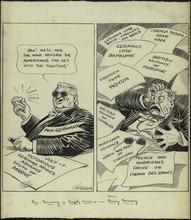
Description: This cartoon depicts a man who has been affected by news of combat in World War I. In the left panel, "Pan-Germany" is confident about his ability to win the war. Pan-Germany is a concept that stems from the ideology of Pan-Germanism. It is a school of thought, which believes all ethnic Germans and German-speaking people should be united under one state, Pan-Germany. While Pan-Germany was never a real state, Germanic peoples still shared a similar language and culture. In the right panel, Germany quickly becomes alarmed as news of Ally victory comes to his desk. Although Pan-Germany was confident of his ability to win World War I, he did not anticipate the United States becoming a serious threat to the war effort. The United States entered World War I on April 6, 1917. (Summary created by Mary Delano, MU History Intern, Spring 2018)
Member of: McCutcheon Editorial Cartoons - ALL (Collection)
Resource Type: Still Image
JM-021: Mr. American reactionary abroad tries to change the opinion of Europe

Description: Editorial cartoon depicting an American visiting places such as France, Germany, and Italy and hearing praise for Roosevelt, which the American does not agree with.
Member of: McCutcheon Editorial Cartoons - ALL (Collection)
Resource Type: Still Image
JM-171: Bi-plane dogfight
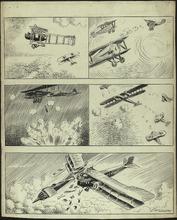
Description: Editorial cartoon depicting five panels of bi-plane dogfight scenes in World War 1. The planes with the iron cross symbol are German planes, while the planes with the roundels are either German or French.
Member of: McCutcheon Editorial Cartoons - ALL (Collection)
Resource Type: Still Image
JM-164: Will there be enough to go round?
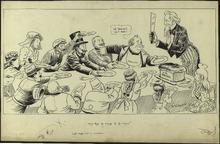
Description: This cartoon depicts Uncle Sam trying to divide "U.S. Bread" among various nations. In 1915, World War I was being fought in Europe, but the United States was maintaining a neutral position. Despite its neutrality, the United States supplied resources and arms to nations during the war. All of the countries sitting at the table are nations who lobbied for resources from the United States during the war. England is attempting to block Germany's chance of receiving resources from Uncle Sam. This is representative the attempts of the British government to limit the United States aid to Allied Powers, most often England. The United States is also sitting at the table, looking worried about sharing the beard with other nations. The United States distributing more resources than it could afford was a fear for many Americans in the 1910s. (Summary created by Mary Delano, MU History Intern, Spring 2018)
Member of: McCutcheon Editorial Cartoons - ALL (Collection)
Resource Type: Still Image
JM-184: Peace talk

Description: The cartoon shows the interpreted process of peace talks during World War I. The top panel shows the German people being dragged to peace by the Kaiser Wilhelm II. The second panel shows the Reichstag calling for peace after the kaiser orders them to begin discussions. In 1917, the United States had entered World War I, and Germany's and the Axis powers' chance of victory was becoming smaller and smaller. This made them more willing to negotiate for peace than in previous years of the war. The third panel shows the American stock market falling in value. This drop in the stock market was caused by the peace talks. Supplying weapons and other resources in World War I significantly improved the economy of the United States. Many factories and other means of productions had been created solely to meet the needs of the global conflict. As World War I came to a close, the United States large profits from the war effort began to decline. (Summary created by Mary Delano, MU History Intern, Spring 2018)
Member of: McCutcheon Editorial Cartoons - ALL (Collection)
Resource Type: Still Image
JM-202: Cartoons of the day
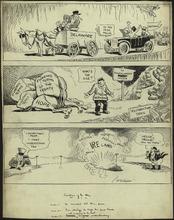
Description: Editorial cartoon depicting three separate cartoons. In the top panel, a man on a cart titled "Delaware" blocks women in cars titled "Suffrage" from passing him on the road to the 1920 polls. In the middle panel, "Germany" kills his pack horse ("Hope") underneath a burden of "Economic Terms of the Treaty"; he is unable to continue on "Reparation Trail". In the bottom panel, Uncle Sam and John Bull attempt to communicate via telephone, but uproar in Ireland blocks connection.
Member of: McCutcheon Editorial Cartoons - ALL (Collection)
Resource Type: Still Image
JM-203: Big Bills
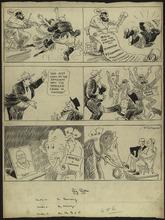
Description: Editorial cartoon depicting three scenes showing the reparations against Germany preventing the country from holding civilization again, the crime wave hitting Chicago even when one man believes he has ended it, and the G.O.P. elephant looking for a candidate but finding Taft being friendly with Wilson.
Member of: McCutcheon Editorial Cartoons - ALL (Collection)
Resource Type: Still Image
JM-315: Storm clouds on the Axis front
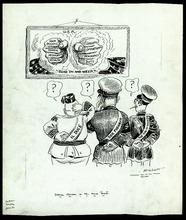
Description: Mussolini, Hitler, Hirohito see powerful U.S. fists.
Member of: McCutcheon Editorial Cartoons - ALL (Collection)
Resource Type: Still Image
JM-W024: In the Allied camp
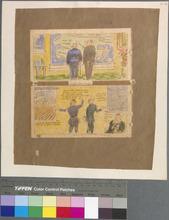
Description: Editorial cartoon depicting Churchill and FDR looking at a map of Europe in the top panel. In the bottom panel, Hitler, Togo, and Mussolini worry about the plane production in the U.S. as the "unpredictable" factor compared to their U-boats.
Member of: McCutcheon Editorial Cartoons - ALL (Collection)
Resource Type: Still Image
JM-272: Make him show his cards
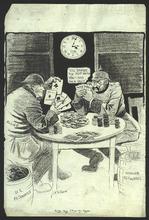
Description: Germany, playing poker with Allies, offers to divide the pot, then quit.
Member of: McCutcheon Editorial Cartoons - ALL (Collection)
Resource Type: Still Image
JM-W025: The straws show which way the wind is blowing

Description: Editorial cartoon depicting Hitler and two others watching as a Berlin monument of victory falls down, while banners show the reasons for the collapse.
Member of: McCutcheon Editorial Cartoons - ALL (Collection)
Resource Type: Still Image
JM-282: The interrupted merger
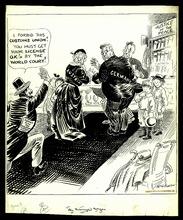
Description: Editorial cartoon depicting the wedding of Austria and Germany stopped by France.
Member of: McCutcheon Editorial Cartoons - ALL (Collection)
Resource Type: Still Image
JM-289: Dancing to the spring song
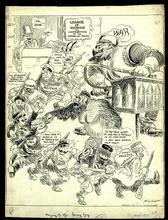
Description: Editorial cartoon depicting men representing nations dancing around "war" organ grinder. The League of Nations watches from a window.
Member of: McCutcheon Editorial Cartoons - ALL (Collection)
Resource Type: Still Image
JM-086: The captain and crew of the William P. Frye, which--
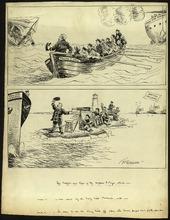
Description: Editorial cartoon depicting a ship labeled the "William P. Frye" being sunk by a ship labeled the "Prinz Eitel Friederich." In the next panel, the crew of the Frye waves the Friederich ship on as it sails to open sea. British cruisers can be seen near the horizon line on the water. The William P. Frye was an American merchant vessel sunk in 1915 after encountering a German ship.
Member of: McCutcheon Editorial Cartoons - ALL (Collection)
Resource Type: Still Image